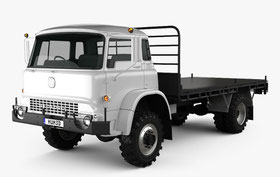BEDFORD Truck PDF Manuals
Bedford R-Series Features
Above on the page there're some Service PDF Manuals, Parts Catalog & Electric Wiring Diagrams for BEDFORD Trucks.
The Bedford RL truck is one of the post-war developments in Britain.
Before Bedford RL truck was a difficult task - to replace the QL series during the WWII.
It was an army vehicle derived from the civilian 7-ton Bedford SCL truck. The military version had four-wheel drive and larger wheels, as well as increased ground clearance.
It was originally rated at 3 tons, like all general purpose trucks in the British Army Bedford RL GS.
Later they were re-priced by 4 tons, but without mechanical modifications, the figure began to show the estimated payload mass over rough terrain.
The last Bedford RL truck produced left the production line in 1973, with a total of 74,000 vehicles rolled off the assembly line.
It was even much larger than the wartime Bedford QL series (52,247) and became the standard British military truck for most of the Cold War for this reason.
Development of the Bedford R series Design and development of the R series began in December 1950 by Vauxhall Motors Limited.
The only prototype was shipped to the Combat Vehicle Research and Development Establishment (FVRDE) in May 1951.
There, the chassis was validated and given serial number FV13100.
Production began in April 1952 at Vauxhalls Trucks, Luton.
The headlights were lowered to meet British standards, and the radiator grill was modified, and from October 1953 the truck began to be produced not only for army, but also for civilian purposes.
The army also received and tested the option of an armored cab with an open top.
Bedford R line began to appear in the infantry and other services from 1952 in the British Army, favorably replacing the WWII Bedford QL as well as the Austin K5 and Ford WOT6.
Bedford RL in 3-ton version. RL received a 4.9-liter gasoline engine, designed for 110 horsepower.
Also produced trucks with diesel engines.
The motor was connected to the cab of the Bedford 4WD chassis, the chassis was mounted by a drilling rig at the Ruston-Bucyrus plant.
Specialized options included recovery vehicles, mobile workshops, vans and cable layers, and a fire engine.
The base truck had a fixed-sided steel body, later modified as a flatbed, with a hinged tailgate, and the payload was protected by a canvas covering supported by a roll bar.
The basic configuration was unarmed, but some users modified the cockpit by adding a gunner's hatch.
The Bedford RL truck was originally equipped with a standard 300 cubic inch 6-cylinder petrol engine.
Later, a liquid-cooled 6-cylinder 330 cubic inch diesel engine was offered.
The first developed 115 hp. at 3000 rpm, and the second - 99 hp. at 2600 rpm.
The capacity of the fuel tank was 118 liters, which made it possible to drive 400 km, the maximum speed was 50 km / h.
The transmission was with a 4-speed transfer case.
The electrical system was based on a 12-volt battery with a negative ground (early models had a positive ground).
For mobility, the truck had servo hydraulic brakes.
Bedford RL is one of the trucks produced for the army, but, as it turned out later, it was also used for civilian purposes, not all modifications were equipped for military operations.



